Harold Gale Displays: KCQ Looks Back at a Company That Celebrated Christmas Year-Round
“What’s your KC Q” is a joint project of the Kansas City Public Library and The Kansas City Star. Readers submit questions, the public votes on which questions to answer, and our team of librarians and reporters dig deep to uncover the answers.
Have a question you want to ask? Submit it now »
By Jeremy Drouin | Missouri Valley Special Collections
’Tis the season for nostalgia: a time to reminisce about Christmases past and beloved holiday traditions.
Many Kansas Citians have fond memories of the brightly lit Christmas Crowns that once illuminated the downtown shopping district and warmly recall festive department store displays. Shiny new toys under beautifully decorated Christmas trees, model trains chugging through snowy townscapes, and mechanical elves, reindeer, and carolers were hallmarks of the holiday shopping experience.
But when it came to Yuletide displays, jolly old St. Nick took center stage.
For more than four decades, a Kansas City company helped make Christmases more merry and bright. Beginning as a home business in the 1940s, Harold Gale Displays became one of the largest manufacturers and distributors of Santa Claus display figures in the U.S.
So, who was Harold Gale and how did he make a name for himself selling Santas? That was the question submitted to What’s Your KCQ?, a community reference partnership between the Kansas City Public Library and The Kansas City Star.
It’s a Kansas City Christmas story we think you’ll enjoy.
The husband-and-wife team of Harold and Viola Gale began making Santa Claus figures out of their midtown apartment around 1946. Harold had worked as a display manager for the Woolf Brothers clothing store, where he designed custom Santas for holiday window displays. When other Woolf store locations sought his services for their Christmas displays, Gale and his wife were inspired to fill a market niche by starting their own business.
The Gale home was a veritable Santa’s workshop as, nights and weekends, they assembled wire-framed figures by hand, painted composite faces, and sewed Santa suits. As sales grew, the couple saved enough to rent a room inside the Manhattan building at 728 Main Street. Soon, the operation expanded to 18 rooms.
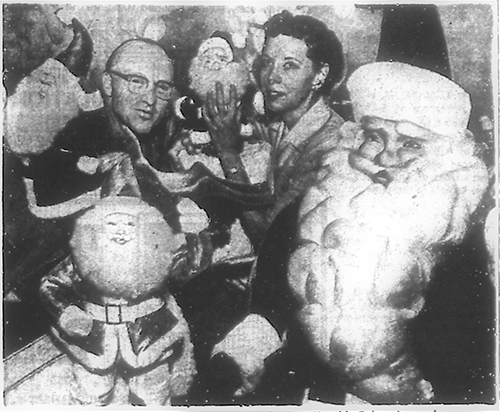
The Kansas City Star, August 31, 1958.
With their business turning a profit, the Gales were also able to purchase a small house in the Westwood neighborhood near the Country Club Plaza.
Like a child’s Christmas wish list, their company continued to grow. By 1957, the Gales had relocated the factory six blocks south to a four-story warehouse at 13th and Main streets. The larger space was needed to house thousands of square feet of lumber, wire, plastic molds, rolls of velvet, and corrugated boxes – essential components in their successful Santa-making enterprise.
As many as 40 employees worked in the plant assembling the Santas and other holiday figures. Viola Gale had a hands-on role in production, overseeing the design, sewing, and cutting of fabric and sculpting of plastic molds.
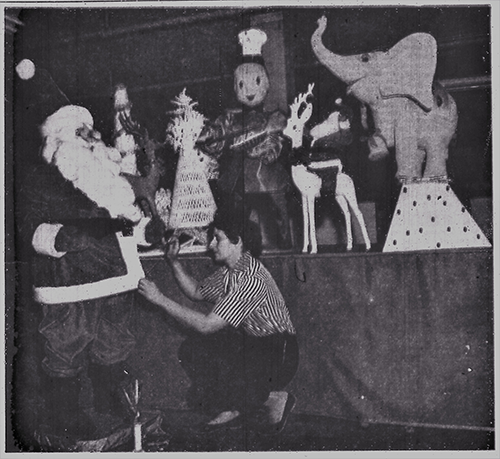
The Kansas City Star, June 26, 1960.
The post-World War II Baby Boom era brought a high demand for children’s toys to be placed under Christmas trees and in stockings. Santa dolls were especially popular gifts. The Gale company was well positioned to enter the burgeoning retail doll market, but not without competition from other manufacturers.
The New York-based Knickerbocker Toy Co., which owned lucrative licenses for Raggedy Ann and Hollie Hobbie rag dolls, produced a best-selling line of 9 and 11-inch, baby-faced Santas in the mid-1950s. And in 1957, the Rushton Company of Atlanta, Georgia, partnered with the hometown Coca-Cola Company to develop a popular 17-inch Santa doll that clutched a miniature bottle of, what else, Coca-Cola.
That same year, Harold Gale introduced a 15-inch Santa doll specifically for retail consumers. It was first available through Sears and Roebuck and as a premium for purchasing 7-Up, Tupperware, and other products, but was later sold in department stores.
The company also released a line of Santa dolls ranging in size from 14 to 26 inches. The popular 14-inch version sold for $3 was commonly outfitted in a traditional red velvet suit with white trim and boots. Alternate versions—now prized by collectors—were outfitted in gold, silver, white, pink, and green.
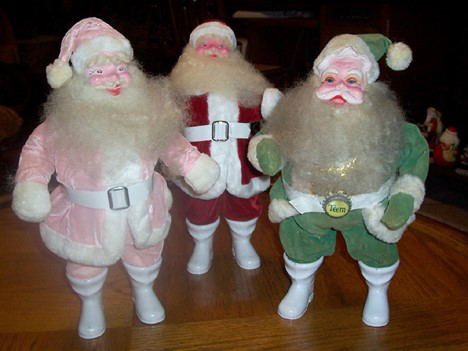
which was introduced by the Pepsi- Cola Company in 1960. From the collection of Mary and John Mullinax.
In 1958, the Gales expanded operations yet again with the intent of boosting production from 65,000 to more than 100,000 units annually. They moved into a 30,000-square-foot warehouse at 2012-2018 Baltimore Avenue and increased their workforce to 60 employees.
The company continued to thrive in the 1960s. It produced a full line of Santa Claus figures, from a few inches tall up to 7-foot store displays, as well as assorted elves, angels, gnomes, snow babies, and animal figures. Christmas-themed products accounted for 95% of the company’s business, which also included Easter display figures.
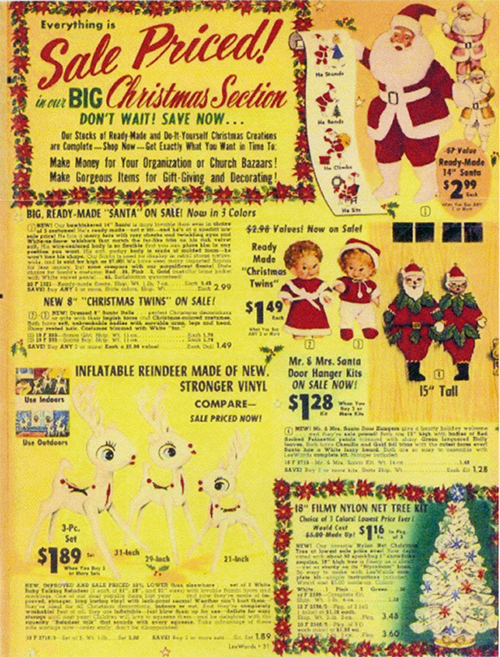
Courtesy of Polly Hackett-Morey.
Like their elven counterparts in the North Pole, Harold Gale employees worked year-round in preparation for the Christmas season. When business slowed in December and all completed orders were shipped to stores, the entire staff would take a much-deserved vacation.
The Gales sold the family business to another display firm in 1966, but Harold stayed on as general manager. At the time of the sale, he estimated that more than 3 million Santas had been produced since the company’s founding.
Harold Gale Displays changed hands again in 1970. Not long after, the Gales moved to California where they lived out their retirement years. Under new ownership, the firm diversified its product line and made custom designs for large companies. However, Santa Claus and other Christmas-themed characters remained top sellers.
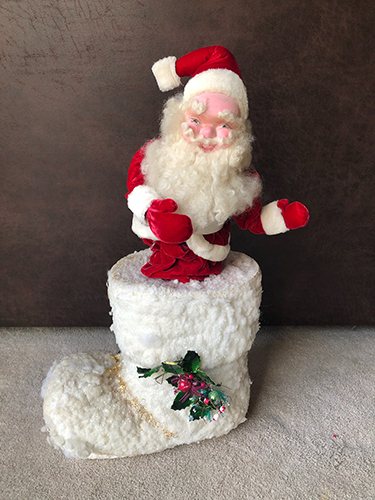
From the collection of Mary and John Mullinax.
The company also specialized in creating elaborate shopping mall displays for clients throughout the U.S. and Japan and designed custom figures for some notable clients. A life-size Santa was created for Kansas City jazz legend Count Basie as a gift for his wife, and an animated Santa driving a Ford Model T was made for President Jimmy Carter’s daughter, Amy.
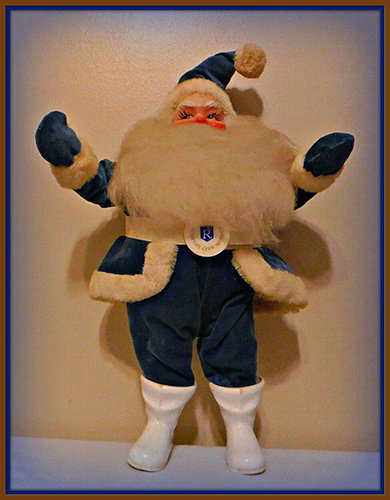
the 1980s, possibly after the World Series victory in 1985. Courtesy of Glenn Waters.
It seemed that Christmas would never end for the Gale company but, alas, the Santa factory on Baltimore Avenue closed in 1986-87 and the facility was vacated. Another Kansas City company, Superior Display, carried the Gale tradition into the 1990s by producing elaborate Christmas displays for Crown Center and other shopping malls throughout the country.
Today, the Harold Gale legacy endures in the numerous display figures and dolls found in private collections and sought by collectors. The next time you unpack your Christmas decorations for the holiday, check to see if a Santa Claus doll is among them. It might very well be a Harold Gale Displays original made right here in Kansas City.
Submit a Question
Do you want to ask a question for a future voting round? Kansas City Star reporters and Kansas City Public Library researchers will investigate the question and explain how we got the answer. Enter it below to get started.
